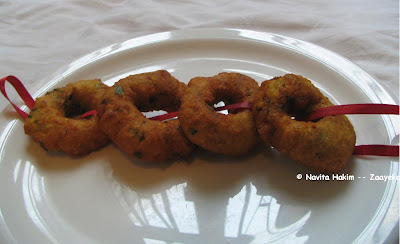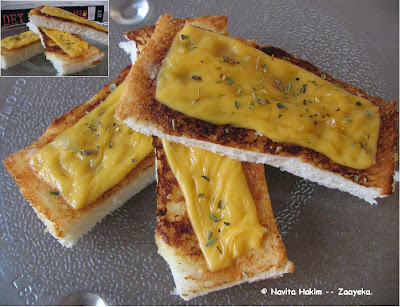Cooking is like love. It should be entered into with abandon or not at all. ~Harriet van Horne

I am a staunch believer of the above adage. So when I got into cooking for my love, after wedlock; I made sure that I didn't restrict myself to only Indian cooking , which incidentally is one of the largest and widely varied cuisine type, afterall 'she' is the oldest and the biggest republic known to the world !
I am always on the look out for new dishes/recipes... constantly stretching my boundaries....challenging myself...and the kitchen provides me with limitless oppurtunities. My haven, and as some dear readers rightly observed that I spend a lot of time in the kitchen..isn't it inevitable with all the infinite possibilities that entyce me.

I want to share here what chiselled my adventurous soul.
My father is a man well-travelled...knowledgeable about people and their ways. I remember the first time I went to a gourmet restuarant (that is the first time I can remember/was aware); my dad handed me the menu and told me to place my own order; while my mum vehemently told my dad otherwise, that he should not let a five year old kid decide what she wanted to eat. In any case I placed my order and ate it all (more so beacuse I wanted to show that I am a grown-up well-mannered girl finishing her plate..;p).
I have always strived to be like my dad, ..perfect...to be an all rounder...be able to strike up a conversation with anyone...on any topic...to be giving and kind....to laugh and be brave. Come to think of it I have been influenced more by the men in life ...can't ignore that I have grown amongst boys, my cousins(mostly brothers), uncles, grand pas'....though my dad being the vital influence.
He is a worldly wise man and unconciously has influenced me in slightly more ways than my mom. My whole character has been shaped on his ideals. I was never the cliched daddy's princess , infact I was constantly questioning with him...arguing...debating...(yes! I wasn't an easy child). He had taught me to think for myself...decide, and then stick by my decisions...hence all the questions and I wouldn't rest till I had the answers convince me. (chuckle)
My mum still says that I was a dare devil born within a body of a girl..a rebel of sorts, all her life she has kept telling me "behave like a girl"..."be a little fearing/coy"...lol..., however she is my grounding-factor.
So taking on my dad, I also have a streak for explorations.....even in the field of cooking/eating. I am blessed that my darling hub shares my passion. We both love having fun...taking pot shots at each other....living on the edge...adventurous...yeah.. we were meant to be..lol. (Touch wood!)

I have dabbled in Indian, Chinese, Japanese, Thai, Italian, French, Greek, African, European cuisines and everything in between! Well that obviously doesn't mean I have made every dish of every cuisine...but hey I have walked the Earth only for twenty-five years yet. :)
We will keep to French cuisine today as this post was inspired by ATOM (A Taste Of Mediterranean)'s current region- France. The event is brainchild of Tony. You can read more about it at Fanny's blog too.
Tony and his Mediterranean blogger friends are on a globe-trotting spree. Every month they will travel to a different region of the Mediterranean by recreating traditional dishes using their own individual styles...ofcourse having fun along the way. They have some gorgeous stamps of each region...which is a collector's item...and I intend to collect all the stamps.

"The French... have surrounded food with so much commentary, learning and connoisseurship as to clothe it in the vestments of civilization itself... Cooking is viewed as a major art form: innovations are celebrated and talked about as though they were phrases in the development of a style of painting or poetry... A meal at a truly great restaurant is a sort of theatre you can eat."
--Richard Bernstein, The Fragile Glory
Indisputably, one of modern France's greatest treasures is its rich cuisine. The French have an ongoing love affair with food, and their reverence for time spent eating is evident in any culinary establishment nationwide. It is also manifested in the traditional family gatherings around the home dinner table, particularly the Sunday mid-day feast which is prepared lovingly over many hours and consumed leisurely through a bevy of appetizers and main courses, usually accompanied by a number of wines and often lively discussion which tends to center on political topics.

It is interesting to note-
What is perhaps less widely recognized is that France's reputation for fine food is not so much based on long-held traditions but on constant change.
In fact, the general expectation of good eating is a relatively new experience for the French. At the time the Bastille was stormed in 1789, at least 80% of the French population were subsistence farmers, with bread and cereals as the basis of their diet, essentially unchanged since the time of the ancient Gauls nearly two millenia before.
The era of the French Revolution, however, saw a move toward fewer spices and more liberal usage of herbs and refined techniques, beginning with François Pierre La Varenne and further developing with Napoleon Bonaparte and other dignitaries, Marie-Antoine Carême.

When it comes to French cuisine, I am yet to try home-made puff pastry....yes I know store -bought do well too...but its my deepest desire to learn the process. Secondly I want to make tarts more often. I do not have any ramekins here, nor muffin trays...yet I made my first tart here in Hong Kong and that too in a basic microwave(not the convection one)....I just couldn't beat the urge to break from tradition. (I can't change me...lol.) Tarts...err..life made easy and quick. ;p
I made my tart savoury, for if you have been regularly reading my blog you would know that sweets rule here...its no wonder I am a dessert-first type of a person. So to balance the yin-yang of this blog I had to make my tarts savoury. :)
This is a twist from the classical pâte brisée, in that that I have used 'sattu' in addition to the regular pastry/all purpose flour and added minced chives to the pastry dough.

'Sattu' is a coarse flour made from various dry roasted grains like roasted barley and dry roasted Bengal gram or 'kala chana' which are actually black chickpeas, not the commonly seen, beige coloured chickpeas most people are familiar with in the West. It has a distinct nutty flavour and is high in proteins, fibre and betaglucan.
It is difficult to assign it an English name that makes sense, so I will just call it sattu.

The fact that the tart turned out right on my first attempt has already raised my spirits by quite a number of notches. I’m not sure what your experience with making tart dough has been like, but mine involved apprehension and nervous excitement. I stopped short of consulting the stars before I embarked on this microwave tart-related endeavour. So, after working my way through a significant number of recipes, I finally arrived at what I call the perfect MW tart dough. The one I made isn’t a classic pâte brisée, but I do adore the richness of this thin crust. It is crisp and flavourful and ofcourse highly nutritous.

Microwave 'Sattu' Tarts
Ingredients-
For Tart Shell (makes four tarts)--
1 egg,cold
1/2 cup butter, chilled
3/4 cup all purpose flour
1/2 cup 'sattu'
a pinch of salt
2 tbsp chopped chives
cold water (for sprinkling)
For Filling--
1 1/2 cup baked beans (either store bought or home-made**)
1/2 cup mozarella, chilled and cubed
2-3 cherry tomatoes, sliced--for garnishing
1 tsp garlic
2 shallots, finely chopped
salt and pepper to taste
1 tbsp butter
Method-
Tart Shell
In the bowl combine flour, sattu, chives and salt. Add in chunks of butter and pulse (in a food processor) or cut through with wooden spoon/butter knife carefully until the mixture resembles very coarse sand.
Note: Do not use too much of your hands, for too long as the heat from the hand will soften the butter fast.
Next,make a well in the center of the flour/meal and crack open an egg in it. Now incorporate the flour slowly to form a soft pliable dough, but not too wet/sticky nor too stiff.
(Use chilled water, if at all required to form the tart dough.)
Wrap the dough tightly in cling foil and refrigerate for 1.5-2 hours.
Roll out the chilled dough to about 0.5 cm in thickness. Using a glass rim cut circles of approximately 8 cm in diameter (pic above) / into a circle large enough to fit your tart pan.
I used the base of my ceramic mugs after inverting them, to make these tarts as I did not have a tart pan.
Press the dough to the base of the inverted mug, without stretching it and pinch any excess off along the edge.
Prick the the dough with a fork several times and bake in the microwave for 5 minutes on medium high.
(In case of using a tart pan, 'bake blind'.)
Cool completely before filling.
Filling
In a saucepan, heat the butter. Add the shallots and garlic. Stir.
Add the baked beans. Season with salt and pepper. Mix well and simmer for a minute. Cool.
Add the filling to the individual tarts. Garnish with cherry tomatoes and top with the cheese.
Bake in MW for 30 seconds on high.
Serve.
I served mine with a dash of coriander viniagrette.

We had these tarts in breakfast and for lunch. Filling and oh so good...I just can't get enough! :D
I also send this over to My Legume Love Affair hosted by Srivalli, the brainchild of Susan.
---------------------------
**Home made baked beans are easy to make. Here is one way I make them.
Step 1-Soak 1 cup of red beans/rajma overnight.
Step 2-The next day, place beans in a large pot and add enough water to cover the beans. Add a pinch of bi-carb/baking soda + 1 tsp of salt and place on medium high heat to boil.
Once the water comes to a rolling boil turn off the heat and remove the beans from the stove. Allow to sit for one hour. This is called a “quick soak” and will soften up your beans and allow them to cook faster.
Step 3-After letting the beans soak for one hour place them on the stove once again and bring water to a boil again. Once the water boils turn the heat down so that the water is still boiling but won’t boil over the top. Boil the beans this way for 1½ hours or until they “pop” (skin breaks open).
Step 4-Once the beans are cooked/done. Remove from heat and drain the water. Place the beans in a crock-pot. Add 2 cups of ketchup with 1 tsp of dried oregano flakes and 1 tbsp of butter. Cook covered, on low heat for half an hour or so.
--------------------------------------------------------
Update: On Vibaas prompt I also send the first picture over to Bee's Jan Click Event @ Jugalbandi.


























































